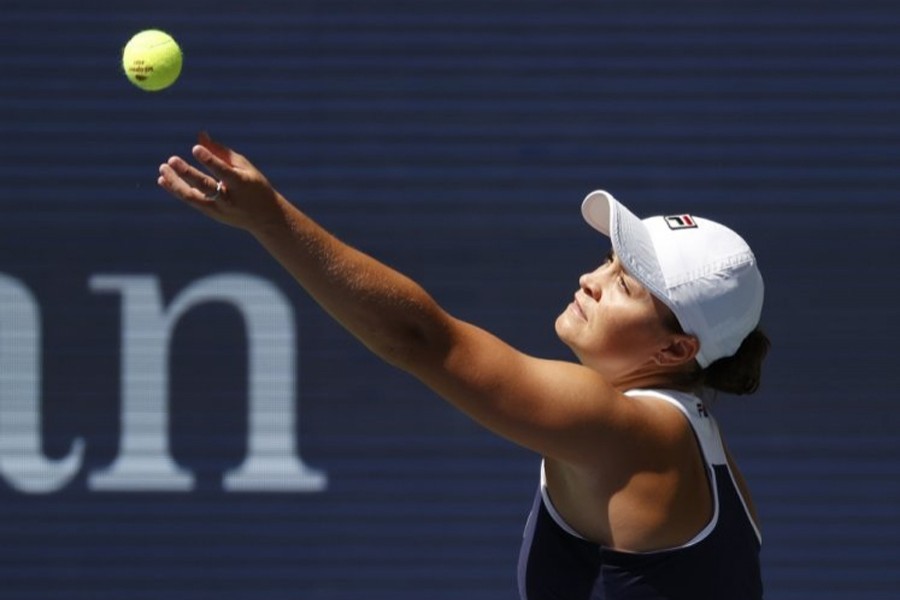Ashleigh Barty, the No. 1 seed at the US Open, watched on match point as her opponent’s backhand sailed long on Thursday, prompting the familiar sound of a linesman yelling, “Out!”
There was no line judge, however. The call was a recording, triggered after an advanced system of cameras known as “Hawk-Eye Live” tracked the ball until it landed out of bounds.
For the first time, the tennis major has installed electronic line-calling on every court, replacing human judges who were responsible for determining whether, say, a serve travelling at 140 mph touched a line the width of a ruler, reports Retuers.
“I didn’t even notice that,” said Chris Foglia, 48, a surgeon from New York, as he and his wife Melissa watched Simone Halep take on Kristina Kucova on Wednesday. “I have very mixed feelings – I like the human element.”
But, a few minutes later, he acknowledged how difficult it was for the naked eye to judge balls struck with the amount of force modern players generate.
“Look at that – it’s ridiculous,” he said, as a replay screen inside Arthur Ashe Stadium showed Kucova had sent a groundstroke long by no more than a few millimeters.
The tournament introduced Hawk-Eye Live on some courts in 2020 partly to reduce on-court personnel due to the coronavirus pandemic, but it kept line judges on its two showcase courts, Ashe and Louis Armstrong Stadium. Prior to that, Hawk-Eye was used only as a replay system when players challenged calls.
Live System
With chair umpires the only on-court officials left, the Open has gone from having a peak of 400 officials to a maximum of around 130, Sean Cary, who oversees officiating for the US Open, said in an interview.
The live system employs a dozen cameras around each court, as well as six additional cameras used solely for foot faults.
“The electronic line-calling is providing a far greater level of accuracy, and therefore it’s providing the players a more equitable playing field,” Cary said.
Hawk-Eye deploys louder, more insistent “out” shouts on close calls, while more obvious ones earn a softer call, mirroring the way human linespeople are trained.
The United States Tennis Association (USTA) recorded judges in a studio making calls, Cary said. Each court can use either male or female voices, ensuring players are not confused by calls made on an adjacent court.
With Hawk-Eye Live in place, players can no longer challenge calls, eliminating one source of dramatic, hold-your-breath moments.
Some fans also pointed out that using the challenges, which were limited, was itself a form of strategy that added a layer of intrigue in tight matches. But others said they approved of the change to avoid bad calls that could alter a match’s outcome.
The system means fewer confrontations between players and officials – a change that left some fans nostalgic for the era when John McEnroe became infamous for his profanity-laced tirades on court.
Human Element
“I think it’s awesome because they can’t argue,” said Diane Mace, 65, before her 71-year-old husband, Ed, interjected: “And I think it’s not awesome because they can’t argue.”
“It takes away the human element,” he continued. “Arguing puts some emotion into it.”
But such conflicts can also turn ugly. Last year, three-time champion Novak Djokovic was disqualified from the tournament after smashing a ball in anger and inadvertently striking a line judge.
In a 2009 semi-final, Serena Williams threatened to shove a ball down a line judge’s throat after a foot fault, earning a point penalty on match point that ended the contest.
Other sports have grappled with whether to wield technology to reduce human error, with mixed reviews from fans.
Major League Baseball, for instance, is experimenting with automated ball and strike calls in some minor league games this year. Some fans have clamoured for “robot umpires,” much to the horror of traditionalists, who view the home plate umpire as essential to baseball’s charm.
In soccer, the use of a Video Assistant Referee (VAR) has drawn criticism from fans for a lack of consistency.
Cary said the USTA has not made any decisions about Hawk-Eye Live for 2022, though he acknowledged it might be hard to go back to a less accurate system.


